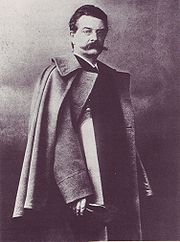
Franz Heinrich Schwechten
Encyclopedia
.jpg)
Germany
Germany , officially the Federal Republic of Germany , is a federal parliamentary republic in Europe. The country consists of 16 states while the capital and largest city is Berlin. Germany covers an area of 357,021 km2 and has a largely temperate seasonal climate...
architect
Architect
An architect is a person trained in the planning, design and oversight of the construction of buildings. To practice architecture means to offer or render services in connection with the design and construction of a building, or group of buildings and the space within the site surrounding the...
s of his time, and has contributed to the development of the historicist
Historicism (art)
Historicism refers to artistic styles that draw their inspiration from copying historic styles or artisans. After neo-classicism, which could itself be considered a historicist movement, the 19th century saw a new historicist phase marked by a return to a more ancient classicism, in particular in...
architecture.
Schwechten was born in Cologne
Cologne
Cologne is Germany's fourth-largest city , and is the largest city both in the Germany Federal State of North Rhine-Westphalia and within the Rhine-Ruhr Metropolitan Area, one of the major European metropolitan areas with more than ten million inhabitants.Cologne is located on both sides of the...
. He attended Friedrich Wilhelm
Frederick William I of Prussia
Frederick William I of the House of Hohenzollern, was the King in Prussia and Elector of Brandenburg from 1713 until his death...
Gymnasium
Gymnasium (school)
A gymnasium is a type of school providing secondary education in some parts of Europe, comparable to English grammar schools or sixth form colleges and U.S. college preparatory high schools. The word γυμνάσιον was used in Ancient Greece, meaning a locality for both physical and intellectual...
, where he was an apprentice of Julius Carl Raschdorff. In 1861, Schwechten enrolled in the Bauakademie
Bauakademie
The Bauakademie in Berlin, Germany, built between 1832 and 1836, is considered one of the forerunners of modern architecture due to its theretofore uncommon use of red brick and the relatively streamlined facade of the building.Designed by Karl Friedrich Schinkel, the Bauakademie was built near...
, studies continued till 1863. After the studies Schwechten worked with Friedrich August Stüler
Friedrich August Stüler
Friedrich August Stüler was an influential Prussian architect and builder. His masterwork is the Neues Museum in Berlin, as well as the dome of the triumphal arch of the main portal of the Berliner Stadtschloss.-Life:...
.

Tiškeviciai Palace, Palanga
The Tiškevičiai Palace, Tiskevičius Palace, or Tyszkiewicz Palace is a Neo-Renaissance style building in Palanga, Lithuania, built for the Tyszkiewicz family. The construction was started in 1893 and finished in 1897. The palace is surrounded by a park with ponds, fountains, and collections of...
in Palanga (Polangen)
Palanga
Palanga and beautiful sand dunes. Officially Palanga has the status of a city municipality and includes Šventoji, Nemirseta, Būtingė and other settlements, which are considered as part of the city of Palanga.-Legend:...
and the Imperial Castle
Imperial Castle in Poznan
The Imperial Castle in Poznań, popularly called Zamek , is a palace in Poznań, Poland. It was constructed in 1910 by Franz Schwechten for William II, German Emperor, with significant input from William himself...
in Poznań (Posen)
Poznan
Poznań is a city on the Warta river in west-central Poland, with a population of 556,022 in June 2009. It is among the oldest cities in Poland, and was one of the most important centres in the early Polish state, whose first rulers were buried at Poznań's cathedral. It is sometimes claimed to be...
. One of the most notable of Schwechten's designs was the memorial church of William I, German Emperor
William I, German Emperor
William I, also known as Wilhelm I , of the House of Hohenzollern was the King of Prussia and the first German Emperor .Under the leadership of William and his Chancellor Otto von Bismarck, Prussia achieved the unification of Germany and the...
, known as the Kaiser Wilhelm Memorial Church
Kaiser Wilhelm Memorial Church
The Protestant Kaiser Wilhelm Memorial Church is located in Berlin on the Kurfürstendamm in the centre of the Breitscheidplatz. The original church on the site was built in the 1890s. It was badly damaged in a bombing raid in 1943...
. He prepared a design of a church with a 113 meter-high tower, retaining late Romanesque
Romanesque architecture
Romanesque architecture is an architectural style of Medieval Europe characterised by semi-circular arches. There is no consensus for the beginning date of the Romanesque architecture, with proposals ranging from the 6th to the 10th century. It developed in the 12th century into the Gothic style,...
style elements. Just after this design was completed, he became a professor. Schwechten died in Berlin and was buried in Schöneberg
Schöneberg
Schöneberg is a locality of Berlin, Germany. Until Berlin's 2001 administrative reform it was a separate borough including the locality of Friedenau. Together with the former borough of Tempelhof it is now part of the new borough of Tempelhof-Schöneberg....
.

